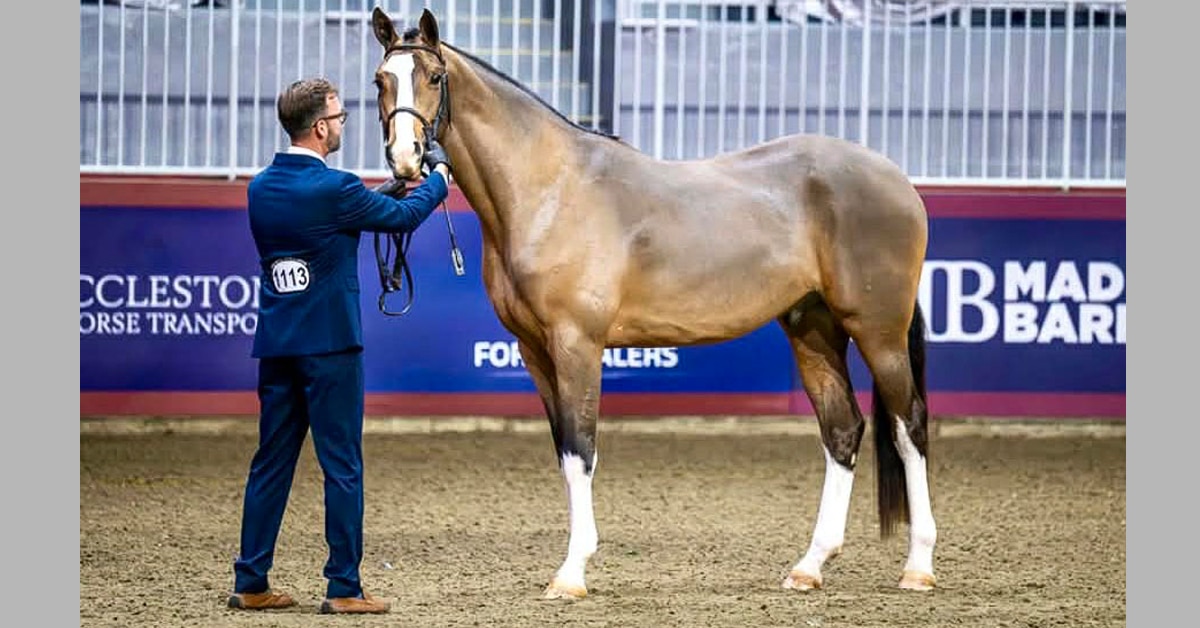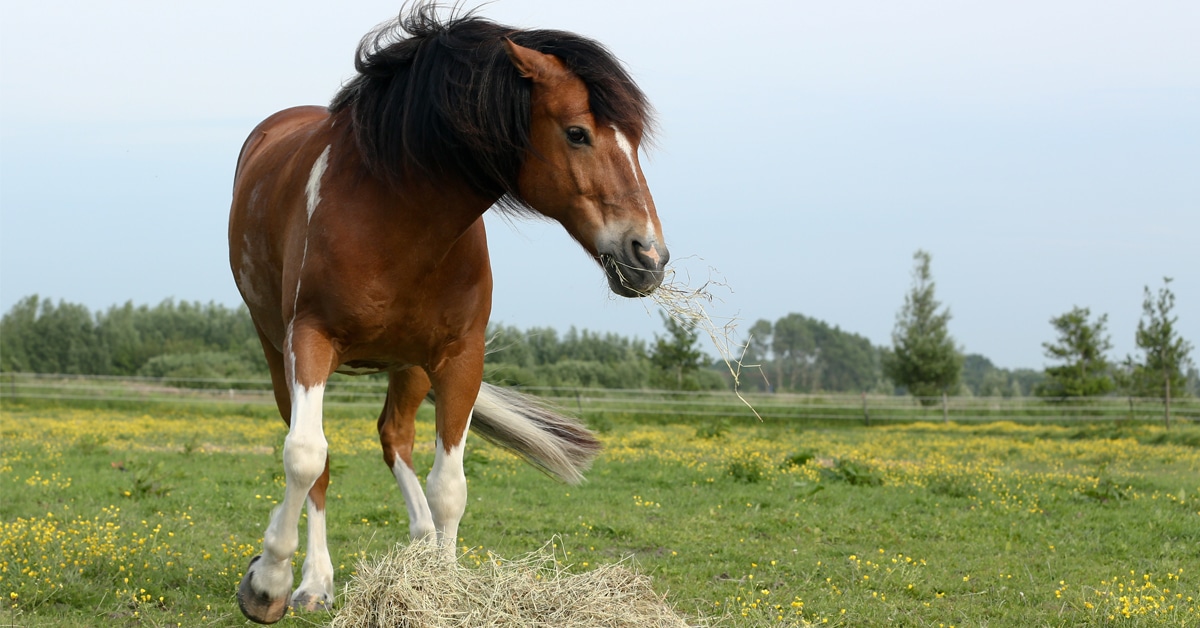Horses are monogastric hindgut fermenters. This means that they have one stomach and are equipped with a large hindgut for fermentation. The hindgut of the horses comprises about 60% of their total gastrointestinal (GI) tract and includes the cecum, large colon and small colon. Understanding how the hindgut functions can equip horse owners with the knowledge to optimally support their horse’s GI function through diet and management.
The hindgut of the horse is a delicate ecosystem that is home to billions of microbes. This includes bacteria, protozoa, fungi and a variety of other microorganisms. The relationship between the horse and the microbes is symbiotic, as both parties benefit.

Hindgut Acidosis
For the hindgut environment to support microbial fermentation, the pH (a measure of how acidic or basic a solution is) must be maintained within a narrow range of about 6.5 – 7. A pH value of 7 is neutral, and neither acidic nor basic; less than 7 means it is more acidic, and more than 7 means it is more basic. When the pH drops for an extended period of time, resulting in a more acidic environment, a significant portion of the beneficial fibre-fermenting microbes die. In turn, there is an increase in lactic acid producing bacteria, further contributing to the lower pH.
When this occurs, there are detrimental consequences to the horse’s health. Common health issues resulting from hindgut acidosis include compromised nutrient absorption, colic, hindgut ulcers, a compromised immune system and leaky gut (where the contents of the gastrointestinal tract are not well-contained due to impaired intestinal barrier function.) Optimizing management to reduce the risk of negatively impacting the delicate hindgut ecosystem is imperative to maintaining health, as the fermentation is critical to the horse’s ability to effectively digest fibre.
Preventing Issues
There are a few steps that owners can take to reduce the risk of their horse developing hindgut acidosis. From providing ample access to quality forage, adjusting management and making nutritional changes, there are plenty of opportunities to optimize care. Below are some key recommendations to support your horse’s hindgut health.
1) Maximize Quality Fibre Intake
Horses have evolved to consume fibrous diets. With some of the intensive management that domestic horses are subjected to, their fibre intake is low and there is a large intake of starch-based cereal grains. For the hindgut to function properly, a horse should be consuming a minimum of 1.5% of their body weight in forage daily.
Most leisure or light riding horses would easily meet their calorie requirements with a forage-based diet, but maintaining adequate forage intake can be challenging for horses that have a high calorie requirement such as lactating broodmares, elite competition horses, and racehorses, to list a few examples. In these situations, it is recommended to understand the calorie content of your hay via an analysis and try to source a forage that will better match their nutrient requirements.
2) Be Conscious of Starch Intake
As previously mentioned, diets that are high in starch are associated with hindgut acidosis. It is preferable for starch and simple sugars to be digested and absorbed in the foregut of the horse, prior to the feed reaching the hindgut. The small intestine is where the majority of this digestion and absorption takes place, as there are a multitude of enzymes.
When large amounts of starch are fed and the diet is lacking in forage, the feed will move through the GI tract rapidly as the stomach is not able to accommodate large meal sizes. This results in undigested starch reaching the hindgut. When this occurs, there is a greater production of lactic acid, contributing to the lower pH.
To prevent this rapid movement through the GI tract, starch-based concentrates should be divided into multiple meals and fed with ample forage. The safety guideline is to not exceed a maximum of 0.5% of your horse’s body weight in grain per meal. For a 500 kg horse, their maximum meal size would be 2.5 kg.
3) Make Changes Gradually
It is well-known among horse owners that changes in feed should be made slowly, often over the course of 7-14 days, depending on volume. This is largely due to the delicate hindgut environment.
The microbial population in the horse’s hindgut will adapt to the feed they are given. For example, a horse that is consuming a forage-only diet is going to have a different population of microbes than a horse that is consuming multiple kilograms of grain daily. So when feed changes are made, understand that the microbial population in the hindgut needs time to adjust. This is why it is recommended to make all diet changes over the course of one to two weeks, including forage! When you receive a new batch of hay, take time to switch it over gradually, as the fibre profile may differ.
4) Consider Beneficial Supplements
When promoting a healthy hindgut, quality forage and careful management of dietary changes are key. However, there are also commercial supplements that can be added, designed to support normal hindgut function, that often include pre- and probiotics and will occasionally include digestive enzymes.
Probiotic supplements can provide additional support to the hindgut ecosystem through the supplementation of beneficial microbes. Probiotics are live microorganisms that are fed to elicit a health benefit. You may also come across the terms pre- and post-biotics when browsing digestive support products. Prebiotics are the readily-fermentable fibre that acts as a food source for the bacteria. Postbiotics are the end products of fermentation (what is left over).
The research support for these products is limited, partly due to the challenges associated with assessing the horse’s hindgut. The main concern is that not enough of the live bacteria survive to reach the hindgut, and that they then do not colonize in the gut. This is an area of science that is growing, but it is important to acknowledge the current limitations.
When choosing a product, it is recommended to ensure that it provides specific bacteria strains that have been proven to be beneficial for horses. It should also provide the number of colony-forming units (CFUs), indicate storage instructions, and provide an expiry date.
Take Home
You can’t have a healthy horse without a healthy hindgut! Understanding how to best support this delicate ecosystem that plays a critical role in digestion is important for preventing health issues such as hindgut acidosis. Providing horses with ample access to quality forage, ensuring any starchy concentrates are fed in small meals, and considering probiotic or yeast-based supplements in times of change or stress are actions that horse owners can take to prevent health issues related to the hindgut.
The Latest










